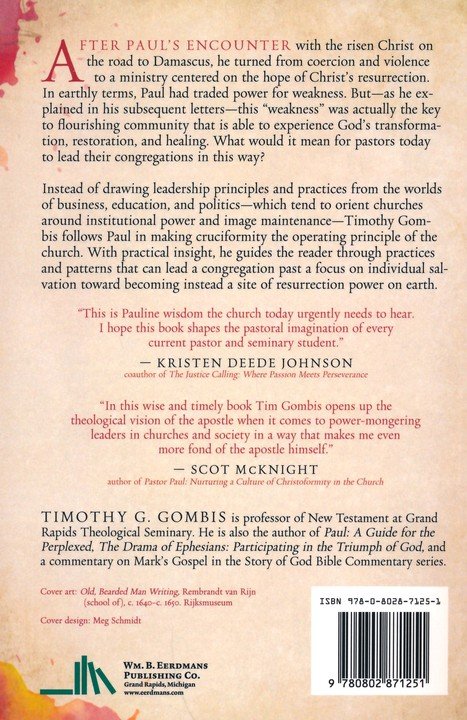
My friend Tim Gombis (Professor of New Testament at Grand Rapids Theological Seminary), is a scholar whose research has centered on Paul. He has previously published an introductory guide to Paul and a study of Ephesians focusing on participation in God’s triumph. But Power in Weakness comes from Tim’s experience in ministry and his conversations with ministers as much as from his studies. It’s my pleasure to reflect with Tim on this topic during the Easter Season, when we commemorate the events that first transformed Paul’s vision for ministry. Easter is never over. It’s the beginning, not the end.
• • • • • • •
I recently spoke with Tim Gombis about Power in Weakness. We talked about how he came to write the book, its content, and who should read it. Most importantly, we discussed Paul’s teaching on cruciformity. Join our conversation here.
• • • • • • •
After a foreword by Michael Gorman and a brief preface, Power in Weakness begins with an account that explains how the book was born out of the Gombis’ role as part of a church leadership team in conflict. This experience led him to read Paul’s letters not just as the basis for theology but also as wisdom for ministry. I think the typical distinction between theology as accurate propositions about God and ministry as wisdom in relating to people is mistaken. No doubt Tim would agree that Paul’s most profound “theological” moments arose out of his intense ministry involvement (e.g. Rom 9-11; Phil 2:1-11).
The first two chapters of the book contrast Paul’s pre-conversion approach to ministry with how he ministered after encountering the resurrected Jesus on the road to Damascus. This encounter altered everything Paul thought he knew, including his approach to people. Paul had previously used his power to violently suppress the church as a way to aggrandize his own status (Gal 1:13-14; Phil 3:5-6). After Damascus, Paul reflected on Jesus’ laying aside his prerogatives and assuming a position of weakness. This led Jesus first to the cross and then to resurrection and exaltation at God’s right hand (Phil 2:5-11). Paul began to view himself as a slave of Jesus (e.g. Rom 1:1; Gal 1:10; Phil 1:1; Tit 1:1) who humbly served the church as he pursued the power of Christ’s resurrection during earthly suffering (Phil 3:7-14). Paul’s “cruciformity” involved intentionally modeling his own life and ministry after that of Jesus, and teaching others to do the same—to shape their identities and lives after the life, death, resurrection/ascension, heavenly session, and coming of Jesus (Eph 2:1-10; Col 3:1-17).
In the rest of the book Gombis explains that Christ’s victory over Satan and evil angelic powers (e.g. Rom 8:38; Eph 1:19-23; Col 2:15) frees ministry from slavery to pride, hubris, competition, and divisiveness, enabling the conflict-resolution and providing unity in the body of believers. He also lays out how Paul’s teaching on weakness helps ministers avoid the pitfalls of image maintenance and credential accumulation. The book concludes with two chapters on how cruciformity transforms how ministers lead their communities.
Rarely will a small book like this one (168 pages) contain so much food for thought. I think Tim is right to point to the Damascus Road encounter as the catalyst for Paul’s transformed thought and approach to life and ministry, but I wonder to what extent Paul’s thought was based in the teaching of Jesus. How much did Paul know of Jesus before his conversion, and how much of Jesus’ teaching was passed on to Paul after his conversion? In particular, I wonder to what extent Jesus’ teaching about his own life and death as a model for his disciplesles (e.g. Matt 10:24-25, 37-39; 16:24-26; 20:20-28) influenced Paul and led to his teachings on cruciformity. One thing is clear, what Paul teaches in Philippians 2:5-11 fits hand-in-glove with what Jesus taught in Matthew 20:25-28 (ESV):
You know that the rulers of the Gentiles lord it over them, and their great ones exercise authority over them. It shall not be so among you. But whoever would be great among you must be your servant, and whoever would be first among you must be your slave, even as the Son of Man came not to be served but to serve, and to give his life as a ransom for many.
My late friend and GRTS faculty colleague Carl B. Hoch Jr.† once wrote a paper entitled “A Great Gulf Fixed.” Carl’s tongue-in-cheek reference to Jesus’ Parable of the Rich Man and Lazarus (Luke 16:19-31) lamented the lack of ongoing communication between the academy and the church, between scholars and pastors. Sadly, Carl’s paper was never published, but Power in Weakness is the type of book that effectively spans the chasm of which Carl spoke. Tim Gombis’ exposition of ministry as cruciform practice shows us that Easter is never over—it’s the beginning, not the end.
More about Power in Weakness

Join my conversation with Tim Gombis here.
You can view the Table of Contents, Preface, and Introduction here.
Tim answers questions about the book here.
The book has been reviewed here.
Catch Tim’s latest thoughts on his website.
• • • • • • • •
Check out my previous posts related to cruciformity and power in weakness:
The Cross: For Us, By Us, and In Us
Sufficient Grace for Fleshly Thorns
• • • • • • • •
So to keep me from becoming proud, I was given a thorn in my flesh, a messenger from Satan to torment me and keep me from becoming proud. Three different times I begged the Lord to take it away. Each time he said, “My grace is all you need. My power works best in weakness.” So now I am glad to boast about my weaknesses, so that the power of Christ can work through me. That’s why I take pleasure in my weaknesses, and in the insults, hardships, persecutions, and troubles that I suffer for Christ. For when I am weak, then I am strong.
(2 Corinthians 12:7b-10)

Leave a Reply